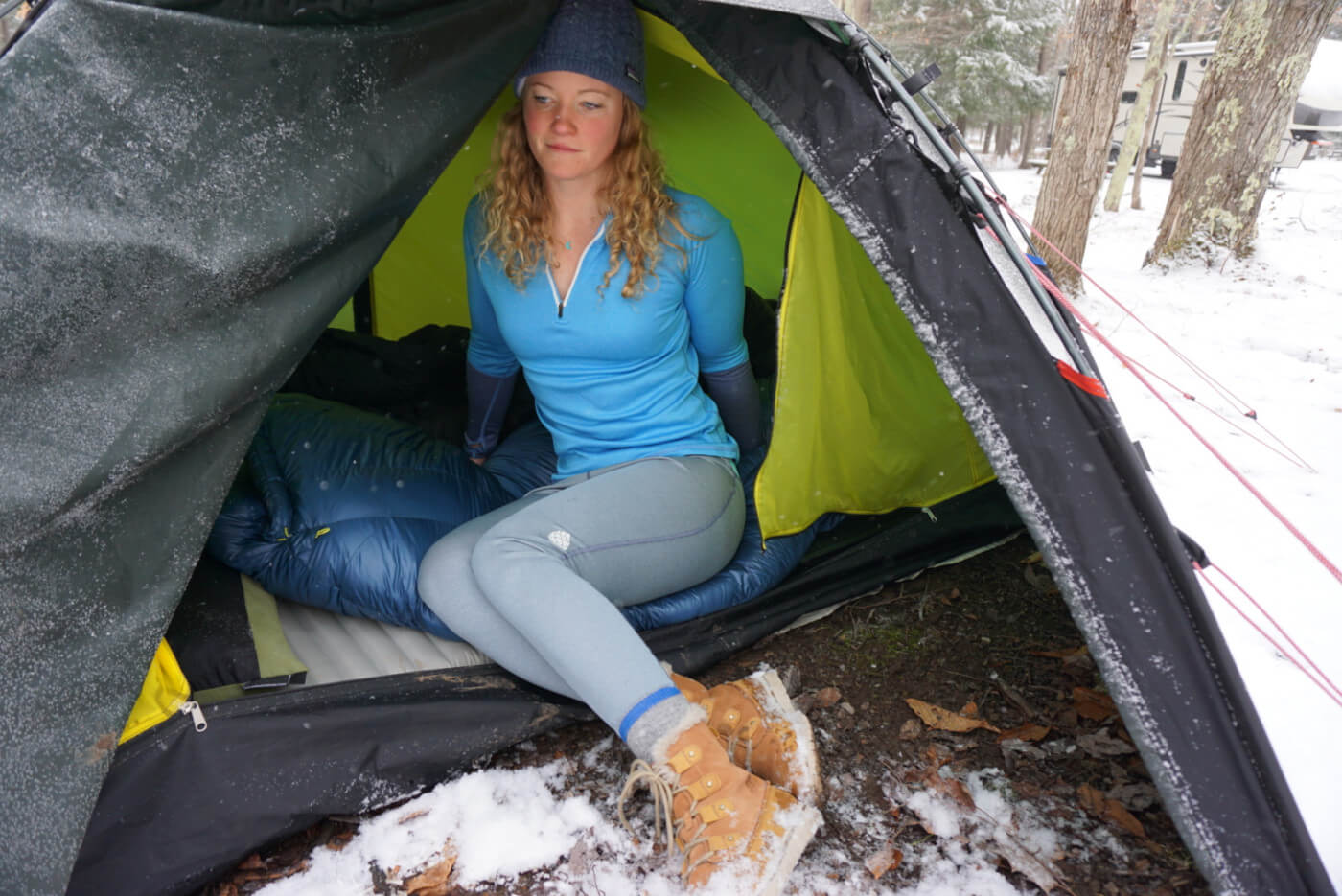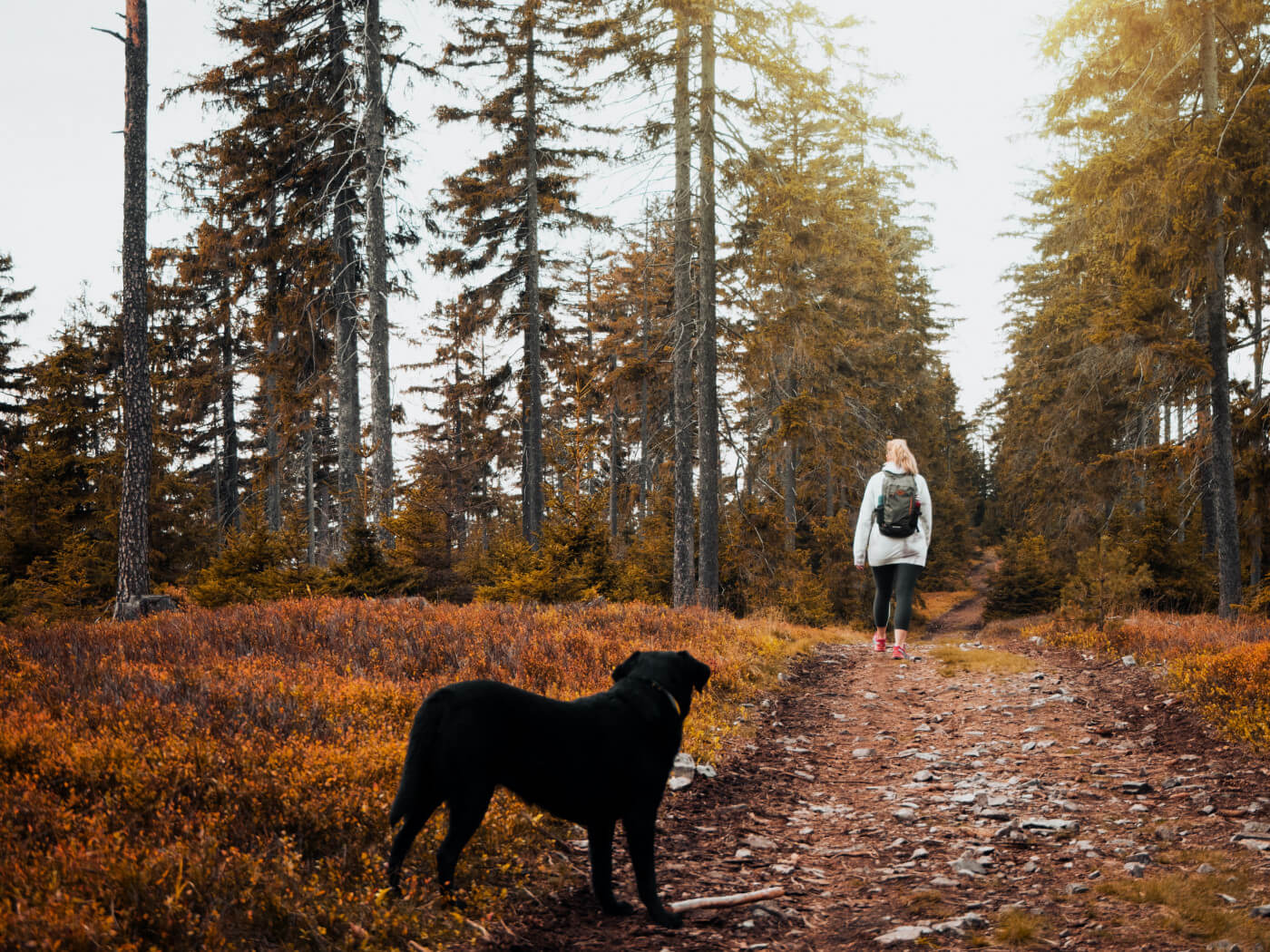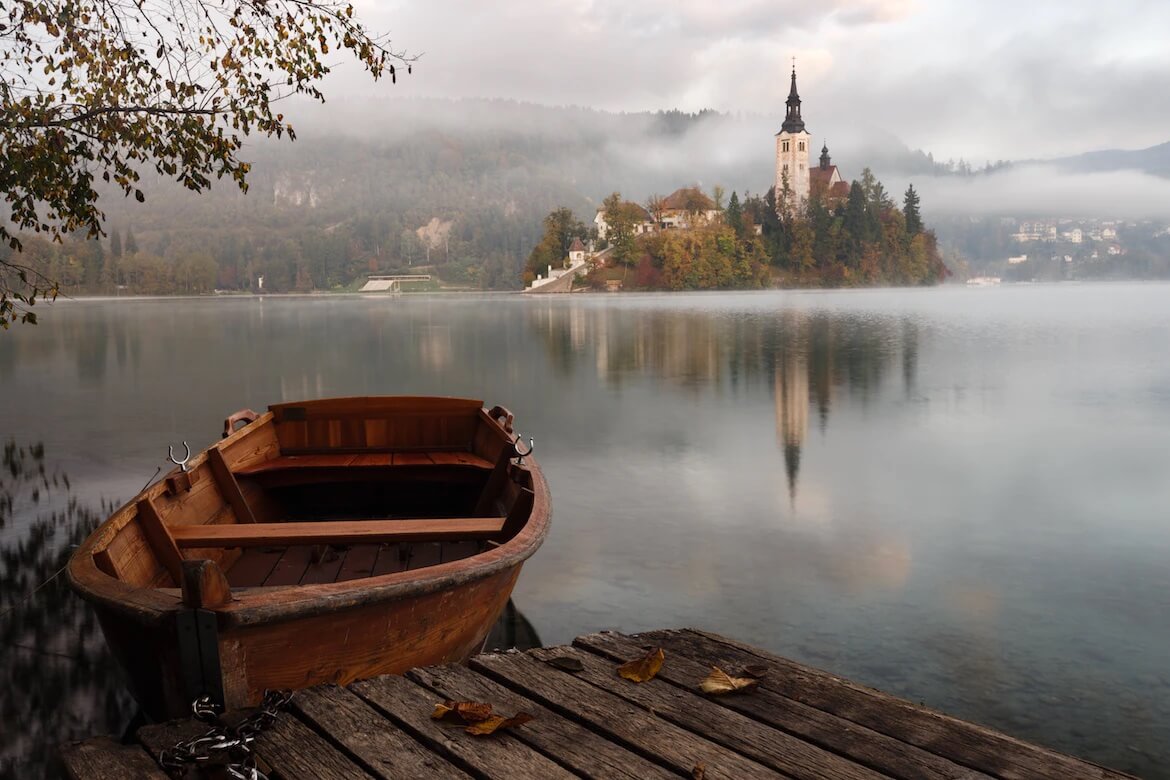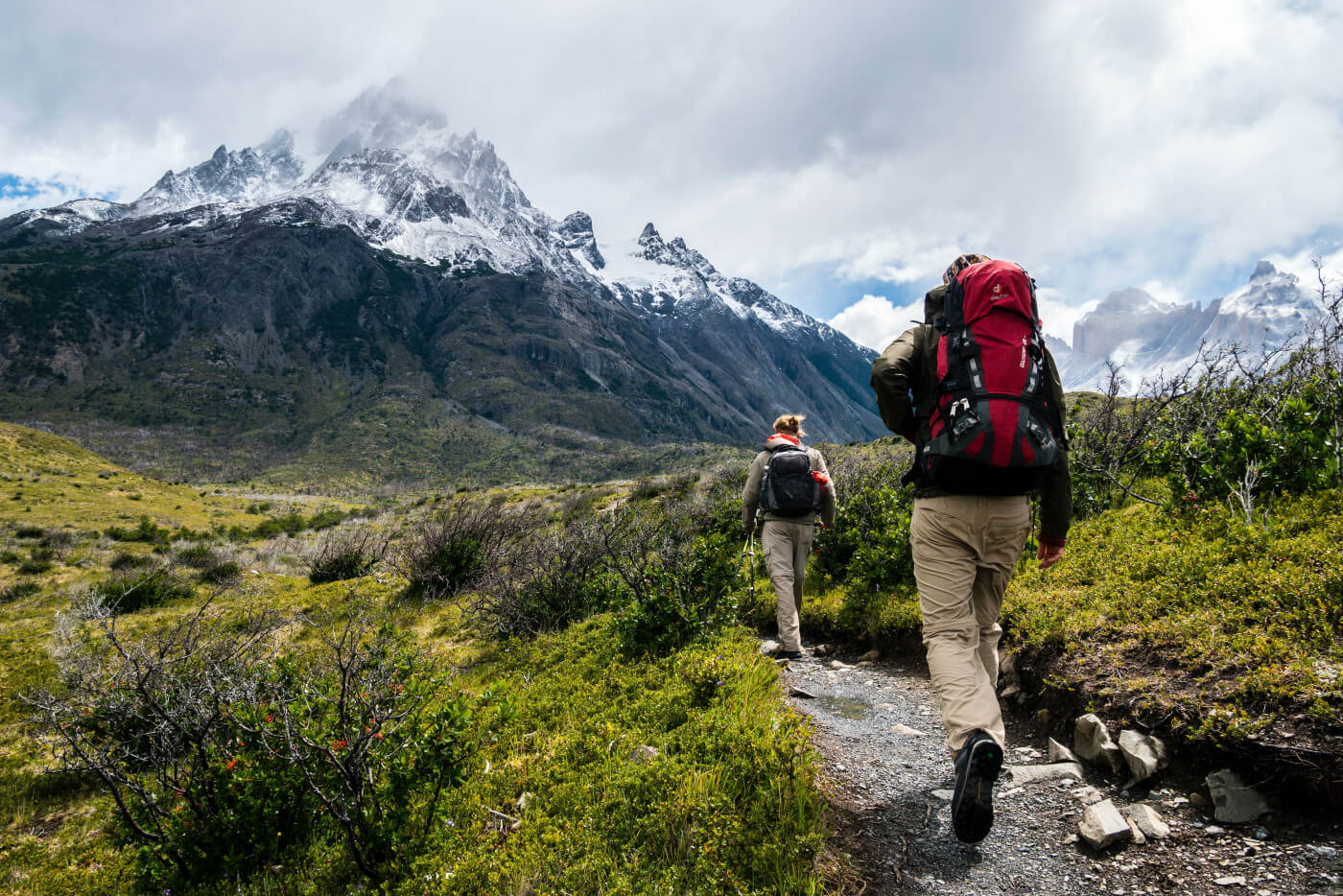In mountain towns and outdoor recreation hubs around the country, autumn’s changing leaves coincide with the end of the busy tourist season. Students are heading back to school and parents returning to work after long summer vacations. Popular trails and campsites previously overrun with crowds become attractive sanctuaries for outdoor enthusiasts.
When you pair a peaceful ambiance with the cooling temperatures, it’s easy to see why fall is a great season for backpacking. But because of the cooler temperatures, fall backpacking can be a miserable experience if you don’t know how to dress for it. Understanding which fabrics are best and how to layer properly is key to staying warm and dry in temperamental autumn conditions.
Follow these suggestions on what to wear for fall backpacking season so you can hit the trails worry-free—rain or shine.

Choosing the Right Fabrics
Autumn weather is often unpredictable—it could be sunny and warm one minute and rainy and cold the next. When choosing what to wear for backpacking in fall, you want to aim for the right balance of warmth and breathability. High intensity outdoor activities demand clothes that keep you cool when you’re on the move, warm when you’re stopped, and dry all the time.
Moisture-wicking, quick-drying fabrics like merino wool blends and synthetics like nylon and polyester are good choices for this purpose. Let’s take a closer look at the pros and cons of different fabric types for outdoor activities.
Cotton
There’s a reason experienced hikers abide by the mantra “cotton kills”. Cotton does a poor job at wicking away moisture from your skin, doesn’t insulate well, and takes a very long time to dry. For these reasons, you should avoid wearing cotton garments for any active pursuit.
Merino Wool
The upsides of wool include its natural breathability, moisture-wicking properties, odor resistance and quick-drying nature. The biggest downside of wool hiking garments is that they come with a hefty price tag. Many hikers opt for a combination of wool and synthetic fabrics, often choosing wool for socks and base layers and synthetics for mid layers.
Synthetics
The benefits of synthetic fabrics — specifically, nylon and polyester — is that they’re very quick-drying, durable, and more affordable than wool alternatives. However, they’re less breathable and prone to stinking more quickly than wool. Merino wool and synthetic blends are an option that offer the best of both worlds.
Silk
Silk is another material found in outdoor-specific clothing but it’s not a great choice for high-intensity cool-weather activities because it’s much slower to wick moisture off your skin. Silk makes for a soft-against-the-skin feel that many hikers covet and adds little bulk, which is ideal from a packing standpoint, but it picks up odors quickly and is much less durable than the alternatives.
Other Considerations
Besides fabric type, there are functionality considerations to keep in mind when choosing what to wear for backpacking. These include things like number of pockets, zipper style, venting system and whether or not a garment has a hood. Features like sun protection and insect repellency are important but less so than in the hot, buggy summer months.
Layering 101
Whether you’re out in the backcountry for an overnight or an extended trip, you need the same essential pieces of clothing. Layering these pieces is what allows you to remain comfortable in changing weather conditions—namely, the ability to add a layer when you get cold or remove a layer when you start to sweat.
Because shoulder seasons like spring and fall are notorious for volatile weather conditions, layering is paramount. As a general rule of thumb, it’s better to bring enough layers to cover a broad range of potential weather conditions. You can always take something off but you can’t don an extra layer that you didn’t bring with you.
Layering Basics
A basic hiking layering system comprises three parts with different but equally important purposes:
• Base Layer (worn snugly; closest to your skin; responsible for wicking sweat off your skin)
• Mid Layer (your primary insulation; responsible for retaining body heat)
• Outer Layer (worn over your other layers; responsible for protecting you from the elements, like wind and rain)
 Photo: The right base layers will keep you warm while lounging around camp in cold weather. Credit: Amanda Ellis
Photo: The right base layers will keep you warm while lounging around camp in cold weather. Credit: Amanda Ellis
The Best Materials for Every Layer
Base Layers
Fabric options for base layers fall into one of two categories: Natural fibers, like merino wool and silk, or synthetics, like nylon and polyester.
In addition to fabric choice, there are different base layer weights to consider — lightweight, midweight and heavyweight. As their names suggest, a fabric’s weight is an indicator of how thick it is and thus how much warmth it will provide. Lightweight fabrics are better choices for warmer seasons while heavyweight fabrics will you keep you warmer when the temperature drops.
Mid Layers
Like base layers, there are a range of natural and synthetic mid layer fabric options. It’s important to remember that your mid layer is your primary insulating layer and you should keep in mind both what it’s made of and the insulating efficiency of the material. The most common mid layer materials include polyester fleece, down insulated jackets and synthetic insulated jackets.
Fleece is a great choice because it stays warm when wet, is super breathable and dries quickly. The downside of fleece is that it doesn’t offer any wind protection so it must be paired with an outer shell.
The pros of down insulated jackets include how well they compress for packing and how warm they are for their weight—offering a better weight to warmth ratio than any other material. The biggest con of down is that it loses its insulating abilities when wet. Synthetic insulated jackets are coveted for their ability to insulate when wet but synthetic insulation is bulkier and heavier than down.
Outer Layers
The main purpose of your outer layer is to provide protection from the elements, including wind, rain and snow. While outer layer jackets are designed to be breathable, most are treated with a durable water repellent (DWR) finish which is what facilitates water to bead up and roll away. Outer layers—also referred to as “hard shells” — fall in one of two categories: waterproof and breathable or water resistant and breathable.
Waterproof shells are ideal for hiking in stormy conditions but are typically more expensive. Water resistant shells are suitable for hiking in drizzly conditions but won’t keep you dry in a squall. However, they’re typically more affordable.

Photo: A down puffy coat provides for excellent insulation. Credit: Amanda Ellis
What to Wear for Backpacking in Fall
Underwear and Bras
Whether you prefer to wear boxer briefs or long underwear, it’s important they’re airy and fit comfortably—not so tight they create the potential for hotspot formation and not so loose that you can’t layer over them without forming creases or folds. Wool or nylon-spandex blends are good fabric choices but like we explained above, avoid wearing cotton.
For women, if you choose to wear a bra the most important consideration is to choose one without clasps or hooks, like a pullover sports bra. Metal hardware found in traditional underwire bras can be squeezed against your back beneath a backpack, which causes discomfort and could lead to sores. The best backpacking bras offer adequate support, comfort and breathability.
Expert Picks:
Women’s Wool Underwear: Smartwool Seamless Bikini
Women’s Synthetic Underwear: REI Co-op Active Bikini
Men’s Wool Underwear: REI Co-op Merino Boxer Briefs
Men’s Synthetic Underwear: ExOfficio Give-N-Go 2.0 Boxer Briefs
Women’s Bra: Patagonia Barely Sports Bra
Base Layer Tops
Depending on the season and weather conditions, base layer tops include both short sleeve and long sleeve options. For fall season backpacking, you’ll probably want to pack one or two of both. A long sleeve base layer will be comfortable for hiking on brisk mornings and cool evenings while the ability to strip down to a t-shirt will keep you cool during the heat of the day.
Expert Picks:
Women’s Short Sleeve Baselayer: Smartwool Merino Tee
Women’s Long Sleeve Baselayer: Seadon Traveler Merino LS
Men’s Short Sleeve Baselayer: Icebreaker 200 Oasis Thermal Crewe
Men’s Long Sleeve Baselayer: Seadon Traveler Merino LS
Base Layer Bottoms
Many hikers opt to wear legging-style base layer bottoms in lieu of (or in conjunction with) traditional boxer brief or bikini-style underwear. They’re ideal for layering under hiking pants in cold temperatures, lounging at camp and donning as sleepwear. Whether you choose lightweight, midweight or heavyweight base layer bottoms comes down to personal preference and anticipated weather conditions.
Expert Picks:
Women’s Long Underwear: Patagonia Capilene Air Bottoms
Men’s Long Underwear: Icebreaker 200 Oasis Leggings
Mid Layer Tops
A mid layer top is worn over a base layer and beneath an outer shell. Fleece jackets are one popular mid layer choice, offering warmth, softness and breathability but adding more bulk than alternatives. Down or synthetic puffy jackets are a second popular mid layer choice, providing greater versatility for hiking in cold conditions and better packability than fleece. Softshell jackets are a third option, serving to bridge the gap between mid and outer layers. They combine a light fleece lining with a water-resistant membrane, offering the best of both worlds.
Expert Picks:
Women’s Fleece Mid Layer: Patagonia Better Sweater 1/4 Zip
Women’s Puffy Jacket: Cotopaxi Fuego Hooded Down
Women’s Softshell Jacket: The North Face Apex Bionic
Men’s Fleece Mid Layer: Patagonia Better Sweater
Men’s Puffy Jacket: Patagonia Nano Puff
Men’s Softshell Jacket: Arc’teryx Gamma SL
Outer Layer Tops
Outer layer tops are more commonly referred to as hardshells or rain jackets. This layer serves as your primary line of defense against the elements. While your mid layer will be the outermost layer you’ll be wearing while hiking most of the time, you should always pack a hardshell. Even if the forecast is sunny, there’s no substitute for a having a hardshell on hand to keep you warm and dry if the weather takes a turn for the worse. The best backpacking hardshell sports a hood and an effective venting system, such as pit zips.
Expert Picks:
Women’s Hardshell: REI Co-op XeroDry GTX
Men’s Hardshell: Seadon Gale VS
Outer Layer Bottoms
Whether you choose to hike in pants, shorts, leggings or a skort ultimately comes down to personal preference. Unless you run warm, shorts are not the best choice to wear on a fall season backpacking trip. Hiking leggings are becoming more popular and can also function as a base layer or sleepwear. The advantages of leggings are that they’re stretchy and comfy to hike in. They’re not water resistant or as durable as nylon hiking pants, however, so you might want to think twice before wearing them through stream crossings or on overgrown trails.
Convertible hiking pants are a popular option for year-round backpacking. They’re functional and built tough enough to withstand rugged trail conditions, making them ideal for adventures that take you off-the-beaten-path. Hiking pants offer features like adjustability, pockets for stashing small items and gaiter attachment points. Convertible hiking pants double as hiking shorts with bottoms you can zip on and off as the temperature fluctuates throughout the day.
Expert Picks:
Women’s Hiking Pants: Seadon Helios Cropped
Men’s Hiking Pants: Seadon Helios Trail

Photo: A hardshell keeps you protected from the elements when you’re hiking in snowy weather. Credit: Amanda Ellis
Socks
Of all the hiking layers and accessories, most hikers would argue that socks are the most important. Well-cushioned wool-synthetic blend socks are ideal for fall season backpacking, especially if you’re wearing boots. Those who hike in lighter weight footwear (trail runners, for example) may opt for a less cushioned sock. Some hikers like to pair heavyweight socks with thin liners.
Other features to look for when choosing a hiking sock include breathability, quick-drying ability and antimicrobial properties. Regardless of what type of sock you chose, always carry multiple pairs with you. This way when your feet start to sweat, you can take off your socks and let them dry while you don a fresh, dry pair.
Hats
Hiking hats are designed to serve one of two purposes: to protect you from the sun or to keep you warm. During the fall backpacking season, it’s likely both will come in handy. Look for a sun hat with a wide brim or a billed cap with a sun cape. For keeping your head warm, a simple wool or synthetic beanie will suffice.
Gloves
Gloves provide warmth for your hands, which can be a game-changer when hiking on chilly mornings and hanging around camp after sunset. Lightweight fleece gloves will do the trick in most conditions. If you’re backpacking in cold and windy conditions, consider gloves with wind protection.

Photo: Backpacking in fall. Baxter State Park, Maine. Credit: Amanda Ellis








